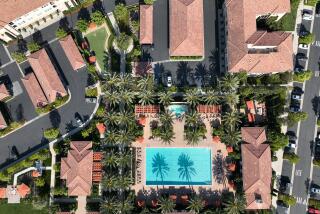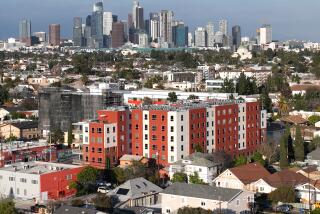West Hills : New Name Helps Pride, Not Wallet
A year after West Hills was carved from the western edge of Canoga Park, the name change seems to have had no effect on property values, despite belief to the contrary by many in both communities.
The average sale price of homes in West Hills this summer rose 17.21% over the same period in 1987, compared to 14.93% in Canoga Park, according to statistics provided by TRW Real Estate Market Information.
But the name change had nothing to do with the increase, appraisers and real estate agents said. They attributed much of the increase in West Hills to expensive new homes in one section of the fledgling community. In the area without new homes, they said, the average sale price of houses increased far less than in Canoga Park.
Still, if West Hills attracts more luxury developments, property values communitywide could increase at a higher rate than Canoga Park’s in the long run, they said.
“The developments in that area are going to make West Hills, not the name,” said William H. Curtis, an independent appraiser based in Westchester.
West Hills community leaders maintain that property values had nothing to do with their separatist movement.
Pride Growing
“The initial petition drive was not over property values,” said Rita Seashore, president of the West Hills Property Owners Assn. “The area is so new that just being an appendage of Canoga Park didn’t work anymore.”
West Hills community leaders say that pride in their community is surging and that new upscale housing developments promise to turn West Hills into a community on a par with such other San Fernando Valley hillside communities as Encino, Tarzana and Woodland Hills.
“I have heard people say that if we can continue on this basis, we can easily become something akin to a Beverly Hills, a Palos Verdes, a La Canada,” said David Mora, publisher of West Hills Life, a weekly community newspaper.
In Canoga Park, some bitterness remains about the secession of West Hills. Many Canoga Park residents think their community’s image has been tarnished.
“The way that it’s going to hurt in the long run is that the Canoga Park name is going to be associated with a less-livable area,” said Bruce Miller, a neighborhood activist and past president of the North Canoga Park Residents Assn. “The inference from the realtors will be, if you can afford it, live in West Hills. The inference will be that Canoga Park is second-class.”
Petition Drive
The idea for a West Hills started in October, 1986, when homeowners along the western edge of Canoga Park launched a petition drive to change the area’s name. The separatists said they wanted to disassociate their newer, primarily residential area from the aging factories and commercial strips of Canoga Park.
After their petitions were submitted, Los Angeles City Councilwoman Joy Picus went along with the name change in early 1987. Unknowingly, she had opened a Pandora’s box.
Soon nearby neighborhoods clamored for inclusion. Neighbors were pitted against neighbors over the boundary dispute. To help resolve the issue, Picus decided to poll the residents.
The results, unveiled Oct. 14, 1987, called for moving the eastern boundary of West Hills from Woodlake and Platt avenues to Shoup Avenue. Councilman Hal Bernson already had given the West Hills name to a small part of his district west of Topanga Canyon Boulevard.
A year later, the topic still provokes discussion at the Scotland Yard Pub in Canoga Park, owner Nancy Fairley said.
“There’s the snob value,” Fairley said.
But most discussions about West Hills focus on property values, she said, with most of her customers who live in West Hills thinking that their property values have risen because of the West Hills name.
‘Very Impressed’
About a mile west of the bar, Esther Lima lives in a house she bought six months ago on Melba Avenue in West Hills. She said she bought the house because it was reasonably priced, not because it was in West Hills. But because of the reaction she gets when people find out she lives in West Hills, she thinks the name will increase the resale value of her house.
“They’re very impressed when I say West Hills,” Lima said. “They say, ‘Oh, good area, you must have paid a lot of money for your house.’ ”
Elayne Eiselman, who lives across the street from Lima, has been in her house for 11 years. The West Hills name doesn’t mean much to her personally. But after the name change, “the value of the house has gone up,” she said.
“People say what’s in a name. I believe everything is in a name,” said Edna Cole, who has lived in her house for 20 years. “Maybe it sounds a little bit snobbish, but it reflects that we live in a better area.”
Indeed, the average sale price of a home in West Hills is higher than in Canoga Park, according to the TRW statistics.
TRW broke down by ZIP code the information on home sales in June, July and August, 1988, and for the same period in 1987. There are four ZIP codes in Canoga Park and West Hills. Two are in Canoga Park, one is in West Hills and one is mostly in West Hills but straddles a small portion of northwest Canoga Park.
West Hills More Expensive
Average prices in the summer of 1988 were $154,107 in Canoga Park and $205,874 in West Hills, compared to $193,089 Valleywide.
The ZIP code for the northern half of West Hills includes the Estates Collection, an expensive new development of 175 homes. Many of the homes have sold for $410,000 to $650,000 in the past year. Average sale prices in that ZIP code, 91304, rose 24.22% last summer over the same period in 1987, accounting for much of West Hills’ overall increase, appraisers and real estate agents said. Average sale prices in the ZIP code for southern West Hills, 91307, which consists mostly of older homes, rose 6.78%.
The TRW statistics do not differentiate between condominiums and single-family homes. Condominium development, which is outstripping single-family housing development in Canoga Park, tends to decrease the area’s average home price because condos are less expensive, appraiser Curtis said.
The San Fernando Valley Board of Realtors said the average resale price of a condominium in the Valley in June of this year was $128,100, compared to $248,800 for a single-family home.
New homes, such as those in the Estates Collection in northern West Hills, can have a temporarily negative effect on the sale of existing houses, Curtis said. This explains the relatively low 6.78% average increase in house prices in the 91307 ZIP code, he said.
Businesses Change Names
But Seashore, the West Hills Property Owners Assn. president, said her group is more immediately concerned with community pride than with property values and development.
Residents have embraced West Hills as the community name, and the association is actively seeking more police presence and better traffic control in the area, she said. West Hills homeowners are taking better care of their property than before, she said. Several businesses have changed their names to reflect West Hills, including the West Hills Market, West Hills Pharmacy and West Hills Flower Shoppe.
But West Hills still has a long way to go to establish its identity, said James Fedalen, association secretary. Many residents have had difficulty getting the U.S. Postal Service and the state Department of Motor Vehicles to put the West Hills name on mail and driver’s licenses, he said.
And some scars remain from last year’s name-change battle.
A schism remains between the West Hills Property Owners Assn. and the West Hills Community Organization. The latter group was formed by residents who were originally left out of West Hills but eventually won inclusion, despite opposition of the property owners’ association. Now the two groups differ on whether West Hills businesses should form their own chamber of commerce.
And then there is the Canoga Park Chamber of Commerce.
Fedalen said that the Canoga Park chamber has a nagging tendency to ignore West Hills, and Seashore bemoans West Hills’ “lack of recognition from that chamber.”
For example, the chamber’s annual chili cook-off, held in July at the Canoga Mission Gallery, is in West Hills, they said.
“I kind of laughed,” Fedalen said. “If they like our community that much, they’re welcome to come in. It goes back to them putting their heads in the sand. They don’t consider it West Hills.”
Ed Petok, the chamber president, put it another way: “There may be lines drawn, but our hearts are still there.”
And he added: “What’s in a name?”
COMPARING HOME SALES
Homes Homes Average Average Sold Sold Price Price June-Aug. June-Aug. June-Aug. June-Aug. 1987 1988 1987 1988 West Hills ZIP code 91304* 190 278 $170,255 $211,490 91307 122 167 $184,046 $196,526 total 312 445 $175,648 $205,874 Canoga Park ZIP code 91303 256 94 $129,337 $142,985 91306 144 213 $142,528 $159,015 total 400 307 $134,086 $154,107 San Fernando Valley 5,879 6,223 $161,112 $193,089 Glendale 970 1,256 $192,083 $230,419 Burbank 481 597 $162,185 $203,189
% Increase In Average Price 1988 over 1987 West Hills ZIP code 91304* 24.22% 91307 6.78% total 17.21% Canoga Park ZIP code 91303 10.55% 91306 11.57% total 14.93% San Fernando Valley 19.85% Glendale 19.96% Burbank 25.3%
* Statistics for West Hills and Canoga Park were obtained through ZIP code boundaries, which did not conform to the precise boundaries of the communities. Therefore, a small portion of northwest Canoga Park was calculated as West Hills for purposes of this analysis.
SOURCE: TRW Real Estate Market Information
More to Read
Sign up for Essential California
The most important California stories and recommendations in your inbox every morning.
You may occasionally receive promotional content from the Los Angeles Times.









